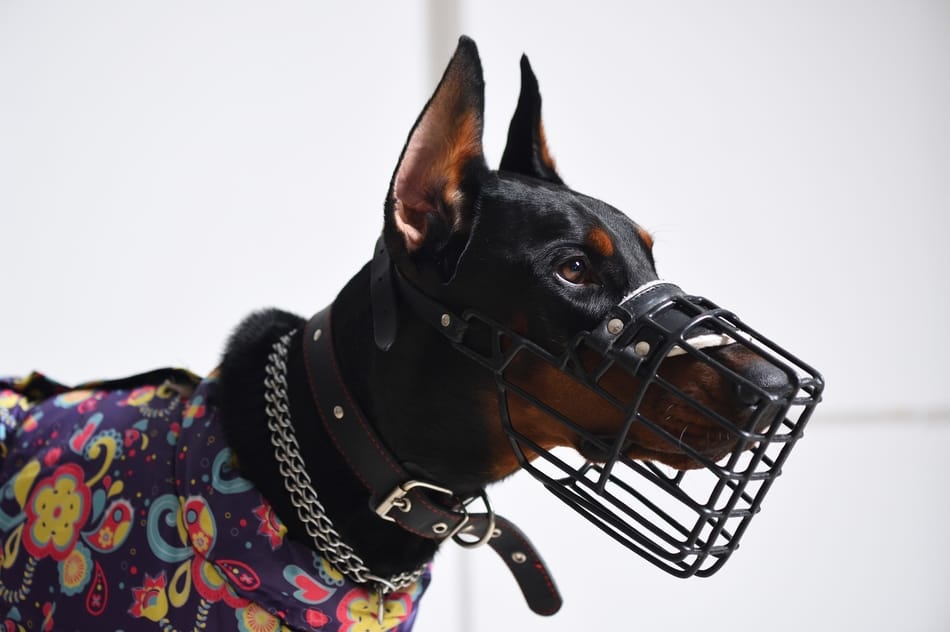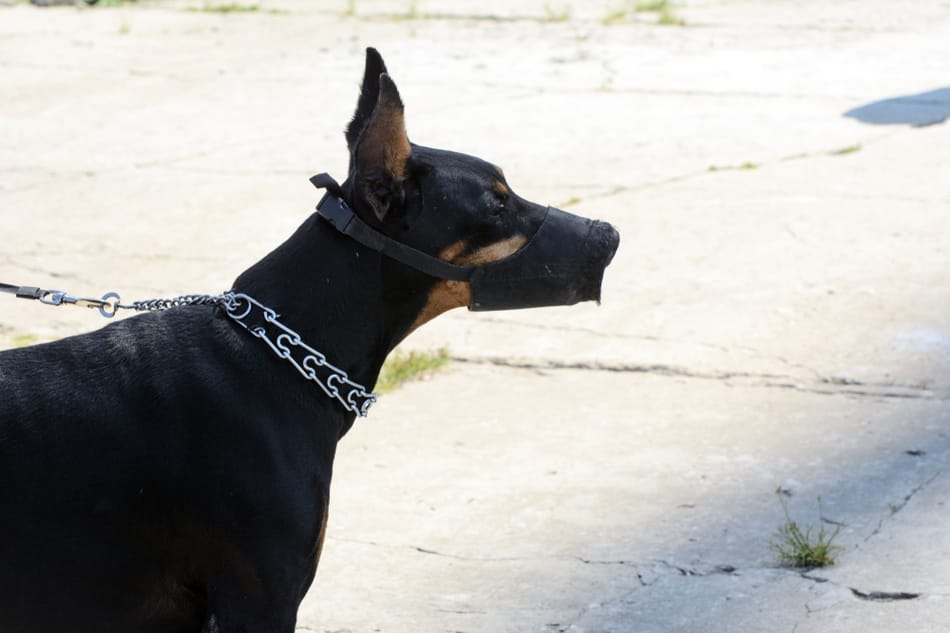
Dobermans are incredibly loyal, strong, and smart dogs who have an undeserved reputation for being aggressive. This may be why people often believe that Dobermans always need muzzles, but in reality that’s rarely the case. Here’s when and why a Doberman may need a muzzle and more importantly—when they don’t.
Do Dobermans need a muzzle? A Doberman normally doesn’t need to wear a muzzle. However, if you have an overly aggressive Doberman, or are unsure of how he may react in a new situation, temporarily using a muzzle may be necessary.
I can say with confidence that Dobermans almost never need to wear a muzzle. However, I still get asked this question a lot, are there are some exceptions to this, so let’s talk about when they might need a muzzle. It really all depends on your Doberman’s history, individual temperament, the situation, and your level of trust of the dog.
Why Dobermans Generally Don’t Need Muzzles
A Doberman Pinscher is considered one of the world’s smartest dogs. Intelligence goes hand and hand with threat assessment. Generally, the more intelligent a dog is, the better they are at proper threat assessment.
In addition, Dobermans are people dogs and love pleasing their owners. A smart dog like a Doberman figures out pretty quickly that aggressive behavior almost always gets a negative response (from most owners). This is why Dobermans are low on the list of dog breeds that may need to use one.
Dobermans are amazing family dogs overall. If you don’t believe me take a look at my article Are Dobermans Good Family Dogs? The Surprising Truth. There you’ll see how they act in family units including with other dogs, cats, and children.
But in general, a muzzle should only be used as a last resort—to be used in extreme cases. However, a Doberman almost never gets to that point due to this intelligence and natural desire to please his owner.
When You Might Need a Muzzle
There are however a few instances where even the most responsible Doberman owners do find themselves using a muzzle on their dog. So, when should you use a muzzle on your Doberman? These situations may include:
- Emergency Situations: If your dog is injured and at risk of biting because of pain or fear, you may need to use a muzzle so that he can get his injury addressed. Most owners believe their dog would never bite them but a dog who becomes severely injured will often bite anyone or anything just due to their altered mental state. It’s a good idea to carry a muzzle in your dog’s first aid kit for this reason.
- Going to See a Veterinarian: Many Doberman owners muzzle their dogs when they bring them to the vet. Sometimes trips to the vet can involve poking, prodding, and other uncomfortable touching that your dog isn’t used to. It’s not a bad thing to have them muzzled for this, just make sure it’s the last thing to go on before the appointment and first thing to come off.
- Being Groomed: If your dog is averse to his grooming sessions, it might be a good idea to use a muzzle. Mostly to make the groomer feel more at ease if nothing else. Some groomers actually require muzzles on every dog they work on. If a muzzle is used during grooming time, just make sure it goes on right before and comes off immediately after the end of the grooming session. The less time the better.
- Legal Reasons: Depending on your location, it may be the law to muzzle your dog if he is considered a “dangerous breed”. Unfortunately, many uninformed people still consider dogs like Dobermans dangerous just because of their breed. So some dog parks, public transportation services, outdoor areas, or municipalities might have rules (or in some cases, laws) requiring you to muzzle your dog.
- Risk of Biting: If your dog is being aggressive, has bitten others before, or is a new dog to you with an unknown past, you may need to use a muzzle in the short term. This is, of course, until you find a vet, trainer, or animal behaviorist that can help address the underlying issue.
- Ingestion of Unsafe Objects (Pica): Unfortunately, Dobermans are known to ingest things that are not edible, a condition that’s also commonly known as pica. The dog can have anything between a mild and a severe case. In the worse cases, a muzzle may be used to help prevent the ingestion of dangerous materials that could lead to expensive surgical treatment or even death of the dog if not prevented.
However, if you think your dog may bite because he feels threatened or fearful in any other specific situation, the use of a muzzle temporarily may provide a workable solution.
There may be other situations, but these are the most common. Owning and occasionally using a muzzle is completely acceptable if it’s done appropriately. Just remember that the less time your dog spends in a muzzle, the better.
For more information about how aggressive Dobermans are, including how many dog bite fatalities they account for in the United States, see my article Are Dobermans Mean, Dangerous, or Overly Aggressive?

When Not to Use a Muzzle
There are certainly many circumstances where it isn’t appropriate to muzzle your dog and can lead to behavioral problems, risks to your dog’s health, and other serious issues. Below are some of these situations.
- For Punishment: Punishing your Dobie by making him wear a muzzle will make him hate wearing it and will increase the fear they have next time you need to put one on. If you need to use it for a valid reason (like when the dog gets hurt), his anxiety will increase drastically and he’ll likely reject it. It’ll also make him more likely to lash out by biting.
- As Any Long-Term Solution: A muzzle should never be used to stop barking or destructive behavior. Those things are a symptom of a bigger problem. In Dobermans, it’s often separation anxiety. A muzzle will only increase this anxiety.
- When Exercising or Playing: A muzzle can restrict the dog’s ability to pant and drink water. Both of these things are very important for your Doberman while engaged in rigorous exercise or playtime.
Also, it’s important not to wear the muzzle in public when it’s not necessary. Dobermans already have a bad reputation thanks to television shows and movies. Unfortunately, people will assume that you have an aggressive dog if they have a muzzle on and it’ll only reinforce breed stereotypes. Really, you wouldn’t be doing the Doberman breed any favors. So please just use it as little as possible.
Introducing Your Doberman to a Muzzle
Introducing a Doberman to a muzzle can take some time and you should never attempt to do it when you’re in a rush. If you slap it on your dog because you are in a hurry, it will likely frighten him so much he will quickly associate the muzzle with fear and anxiety. A slow, progressive approach (with a reward and praise) is a great way to introduce him to his new muzzle.
Start by showing your Dobie his new muzzle and holding it while playing a game and praising him. This will start his positive associations with the device. Then let him sniff it and encourage him to get closer. Then praise and reward again.
“A muzzle is a tool that should be used as little as possible—and only as a means to fix another issue.”
– John Watler (DobermanPlanet.com)
Now I like using the peanut butter trick with this personally. To do this, put a little peanut butter on the muzzle so your dog will lick it, then praise and reward again. Continue putting the peanut butter further and further into the muzzle until they’ve put their whole nose into the muzzle to lick it.
As this happens, make sure you take the muzzle off as quickly as possible when they’re done licking up the peanut butter—then praise some more. Slowly increase the time you leave the muzzle on until you can completely latch the muzzle on and he’ll be a happy camper. Don’t rush this and only add very small increments of time as you go.
Muzzle Comfort
It’s important that whatever muzzle you use is comfortable for your Dobie. If it’s not comfortable then you’ll have a real battle getting him to wear it and every time you do, it may be setting his behavior back a few steps (rather than helping it).
There are two main types of muzzles:
- Basket Muzzles – These are cages of a hard material surrounding your dog’s mouth. They’re usually plastic, metal, or leather. They are more comfortable for your dog than the soft fabric muzzles because they allow him to open his mouth, pant, and even drink water.
- Fabric Muzzles – Fabric muzzles are much less comfortable and although some say they look less intimidating, are more dangerous for a dog. They work by holding the mouth shut. This prevents your dog from panting or drinking water. They are also much harder for the dog to learn to accept because of their discomfort.
Try to get some form of a basket muzzle for your Doberman. When fitting it, make sure the muzzle is adjusted so it’s loose without being so loose that it might slide off or be easy for your dog to remove by pawing at it.
Conclusion
Muzzles are not a permanent solution to a problem you are having with your Doberman and they should only be used as a temporary tool while addressing another issue. Regular use of a muzzle is likely to make your Doberman frustrated and potentially even more unpredictable in their behavior.
A muzzle may not look very attractive, and most Dobermans will not require a muzzle in any circumstances, but there are many reasonable circumstances where a Doberman may require one like if it is the law where you live, or if he needs medical care and is resisting by trying to bite those tending to him.
If you must use a muzzle with your Doberman, then make sure you use it properly so that it doesn’t hurt him and is comfortable as possible.
Never use them to quiet your dog or prevent him from chewing on something in the house that he shouldn’t. This is not appropriate usage of a muzzle and instead, you need to focus on the reason why he’s acting out in that way and correct that first. Most of the time, with proper training, you can avoid the use of a muzzle entirely.
Related Questions
Is it cruel to muzzle a Doberman? Using a muzzle on a Doberman is not cruel depending on how it’s used, although it’s rarely necessary. Some responsible owners will use a muzzle during visits to the veterinarian or dog groomer, or during emergencies when the dog becomes injured.
How long can you muzzle a Doberman? It’s a good rule of thumb to avoid putting a muzzle on your Doberman for more than 20 to 30 minutes at a time. Wearing the muzzle longer is not necessarily harmful to your Doberman as long as they’re supervised and the muzzle is removed if there are any signs of distress.



You don’t mention at all the perhaps appropriate usage of a muzzle on a Doberman to prevent eating inappropriate items. Having just lost a young family Doberman to PICA, believe me, we are very conscious of using a muzzle on our other Doberman as a prevention measure. The alternative is not letting the dog have any freedom to explore. Of course we did proper training with both dogs from an early age, to not touch tissues, eyeglasses, poop etc, but the PICA issue is very serious, and we learned the hard and tragic way. A muzzle can be a preventive measure, and we choose to let the dog have some freedom to explore, be a dog, and without the fear of grave consequences. Perhaps you could do an article on PICA, as evidently Dobes are quite prone to this.
Very good point Barbara! I have done some more research on this and have added information about PICA to this article. I think you’re right, and this information could really help others!